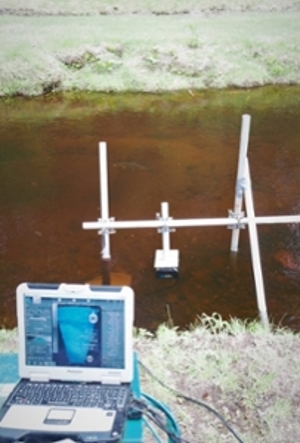Object and behavior differentiation for improved automated counts of migrating river fish using imaging sonar data
Author: Helminen J., Linnansaari T.
Posted on Apr 8, 2021
Category: Publications , Research
Abstract: Imaging sonars, such as the Adaptive Resolution Imaging Sonar (ARIS; Sound Metrics Corp.) produce continuous stream of sonar video footage, and they are commonly used for counting and sizing migrating fish in rivers. Although automated methods have been developed for processing imaging sonar data, manual analysis of the data is still common in fish population monitoring projects. In this study, we used Echoview software to automatically produce fish counts from long-range (up to 30 m) imaging sonar data in a prominent Atlantic salmon (Salmo salar) river; the Little Southwest Miramichi River, New Brunswick, Canada. We added postprocessing steps to address sources of error that have been reported in previous studies: 1) Major Axis Distance was used to filter out erroneous fish tracks (89 % of dynamic noise and 67 % of milling fish in the test-set) and to calculate the swimming direction (96 % correct), and 2) a logistic regression (target length, average speed, and absolute fish track change in range) was used to predict downstream moving fish from other objects with a test-set accuracy of 84 %. When 15-min tally counts were compared between computer-generated data and multiple human-generated counts, the mean of differences varied between -39 % and 65 % in the upstream counts in different datasets, and different analysis methods were in a good agreement between each other (ICC = 0.79). There were larger differences in the downstream counts where the mean of differences varied between 14 % and 115 % and there was no agreement between the datasets (ICC = 0.03). With a double-tracking method where the fish were tracked twice, the computer analysed the 24 -h datasets in 500−600 min and was slower than human-generated counts that required 200−600 min, however, computer generated-counts can be derived in the background without the presence of a technician and may produce significant savings in personnel cost.
Authors:
Author affiliations:
1 Canadian Rivers Institute and Biology Department, University of New Brunswick, 100 Tucker Park Road, Saint John, New Brunswick E2L 4L5, Canada.
2 Canadian Rivers Institute, Faculty of Forestry and Environmental Management, University of New Brunswick, 28 Dineen Drive, Fredericton, New Brunswick E3B 5A3, Canada.
To read the entire article go to doi: 10.1016/j.fishres.2021.105883

